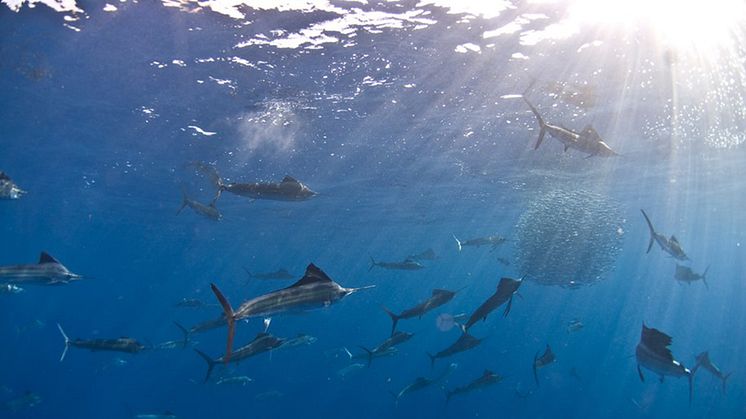
Press release -
Cooperation profitable for sailfish
Cooperating sailfish catch more fish per time than if they hunt individually, a new study from Uppsala University, published in the scientific journal Proceedings of the Royal Society B has shown.
“This is a completely new form of hunting in packs that has not been measured before. When sailfish, Istiophorus platypterus, attack sardines, Sardinella aurita, they take turns to attack the prey school. They strike with his sword, injuring multiple sardines. When the sardines are injured, they are easier to catch,” says James Herbert-Read, a researcher at the department of mathematics at Uppsala University and the Department of Zoology, Stockholm University and the author who led the study.
Sailfish belongs to the genus billfish. They can grow up to 3.5 meters long and weigh around 100 kilograms. Sailfish are one of the world's fastest fish and swim at over 40 kilometres per hour. Scientists have long known that sailfish use their bills to catch their prey by slashing at the prey. They also do not use their speed to catch their prey. But exactly why sailfish hunt in groups was unclear.
The study shows how collective benefits of group hunting can be achieved through a very simple mechanism. The slashes by the sailfish’s bills damages multiple sardines, but a sailfish will only eat one sardine at a time. Because injured prey are easier to catch, this makes it easier for subsequent attackers to catch fish. This means that sailfish can hunt the same way, whether in groups or alone, but it is more efficient and provides higher capture rates to hunt with others.
This field study was done offshore Cancun in Mexico. Scientists have filmed the attacks and then analysed the films.
“We then developed a mathematical model that explains the dynamics of the hunt. We show that it pays to hunt in packs of up to 70 individuals. Individual sailfish will catch more prey per time in these groups sizes compared to if they were hunting alone,” says James Herbert-Read.
The scientists believe this form of group hunting can explain how more complex group hunting strategies evolved among different species.
James E. Herbert-Read et al. Proto-cooperation: group hunting sailfish improve hunting success by alternating attacks on grouping prey, Proceedings of the Royal Society B (2 november 2016) DOI: 10.1098/rspb.2016.1671
Contact:
James Herbert-Read, researcher at the department of mathematics at Uppsala University and the Department of Zoology, Stockholm University,
Tel: +46-76-3372666, www.JamesHerbertRead.com
Topics
Uppsala University -- quality, knowledge, and creativity since 1477
World-class research and outstanding education of global benefit to society, business, and culture.
Uppsala University is one of northern Europe's highest ranked academic institutions. www.uu.se
